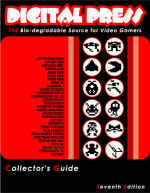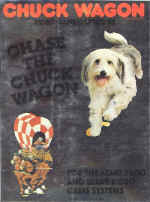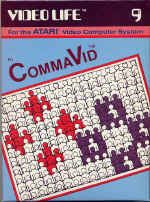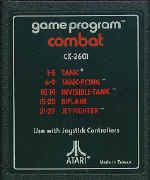
Atari 2600

Today's game player thinks he lives the good life. And who's to argue? After all, game consoles are dropping in price, and with CDs allowing for low software prices and a large storage medium, the graphics quality and sophistication of videogames keeps getting better and better. And with every new game and console being hyped as "the next big thing," it's high time that we remembered THE thing - the real deal that transformed videogames from a mere curiosity enjoyed by a few into an industry that's now several billion dollars strong and driven by marketing types crunching numbers instead of code.Much of the credit for legitimizing the industry belongs to the Atari VCS, and in our opinion, it represents the single biggest forward step in the history of electronic entertainment. Before it became the platform of choice, the gaming market lacked cohesion and continuity. The VCS turned the spotlight away from single-purpose Pong machines to the software-centered systems which have dominated the field since the late 1970's.Atari wasn't the first to introduce a home programmable system. RCA and Fairchild preceded it, and the Odyssey2 debuted at roughly the same time. And both the Bally Astrocade and Mattel Intellivision were vastly superior pieces of hardware. Atari gets the credit (and deservedly so), because it alone had the talent, perception and will to make the kind of games that converted non-players into enthusiastic participants.Not that Atari charged into this sunlit future without a hard push from behind. The concept of a software-centered game hobby was so foreign to the company, which made its first mark with single-use coin-op units, that it originally opposed the concept of third-party software. In fact, Atari originally intended the VCS to last for no longer than one or two holiday selling seasons along with simple Pong-like games, that they handicapped the system with a paltry 128 bytes in order to keep the machine affordable for the few years that they would sell it.After awhile, though, sales proved the validity of a software-driven formula much in the same way that razors are sold cheaply in order to make money on an endless number of razor blades. The hobby has never looked back.Although it was released in 1977, the VCS didn't really start to take off - and leave Intellivision and Odyssey2 sucking air - until a home version of Space Invaders was released, which is arguably the first "killer app" for a game machine in history. And by the early 80’s, the 2600 - as it would later be called - was selling like hotcakes, and programmers at Atari, Activision and Imagic had made tremendous programming strides that significantly improved upon the dots and dashes found in earlier VCS efforts. The 2600 became embellished with a large number of "must buy" titles such as Demon Attack, Pitfall!, Defender, Asteroids, Missile Command, Kaboom!, River Raid, Enduro, Frogger and Montezuma's Revenge.Starting in 1981, the 2600's library of titles began to rapidly expand, thanks to unprecedented third party support. The famous board game behemoth Parker Brothers brought home hit arcade games like Q*Bert, Popeye, Super Cobra and Frogger, and produced games based on licensed names such as Star Wars, G.I. Joe and James Bond. Several movie and television-based games came courtesy of Twentieth Century Fox. M*A*S*H, Flash Gordon and Porky's were among the titles that were backed by huge marketing hype from the company. Venerable coin-op producer Sega got its start in home gaming with translations of Tac-Scan, Congo Bongo, Buck Rogers and others. Tigervision, a subsidiary of Tiger Toys and an established player in the handheld game market, took at stab at software publishing with computer game translations (Threshold, Jawbreaker), obscure coin-op ports (River Patrol, Polaris) and even a movie-licensed game (King Kong.) Craving for a share of the large software pie, CBS and its marketing machine brought out arcade translations and supported them with full-scale advertising campaigns. U.S. Games, a subsidiary of Quaker Oats, opted to make original - albeit bland - games such as Space Jockey and Picnic.The fact that the videogame marketplace was still in its infancy allowed numerous start-ups to have a fighting chance against the goliaths of the industry. Data Age, Spectravision, Telesys, CommaVid, Venture Vision, Sunrise, Ultravision and Apollo were among those that were so small that they wouldn't have had a fighting chance to survive in today's brutal market climate. To really get a good idea of how popular the 2600 was at the time, there were actually five games designed specifically to promote other products: Kool-Aid Man (Kool-Aid), Chase the Chuckwagon (Dog Chow/Puppy Chow), Tooth Protectors (Johnson & Johnson toothpaste), Pepsi Invaders (Coca-Cola), and Polo (Ralph Lauren).Not to be left out, even rivals of the Atari 2600 soon began pumping out cartridges. Under the M-Network name, Mattel translated inferior versions of their Intellivision titles for play on the 2600. Coleco later followed suit with some of its ColecoVision offerings. And North American Philips, the parent company of Magnavox, announced several titles for the 2600 although none were ever released.Besides software, a multitude of controllers, peripherals and accessories edged their way into consumers' budgets. Amidst the dozens of dual-button, rapid-fire joysticks appeared two remote-control units (by Atari and Gamate), a Tron arcade stick (M-Network), an Asteroids-type button-only controller (Starplex), and a miniature Power Stik (Amiga) designed to fit in the palm of your hand. In contrast, The Boss (Wico) is an oversized stick resulting in somewhat awkward control. Devices such as the ROM Scanner (Marjac), the Compro Electronics Videoplexer and Game Selex (Starplex) allowed instant access to several cartridges at the push of a button or turn of a dial. The Supercharger (Arcadia/Starpath) and the Kid-Vid (Coleco) interfaced with a tape recorder. A Foot Craz Controller (Exus) and the Joyboard (Amiga) required interaction with one's feet. Milton Bradley's Flight Command and Cosmic Command controllers were packaged with Spitfire Attack and Survival Run, respectively. These bulky peripherals are more or less gimmicks, as standard joysticks can perform equally if not better. A very early Atari release, BASIC Programming, is used in conjunction with special keyboard controllers. Atari also developed a prototype computer module tagged "The Graduate", although it was never released. Spectravision's Compu-mate is a computer add-on that saw very limited release in the United States. Via a modem, the Gameline Master Module offered gaming services over phone lines. Answer Software's Personal Game Programmer-1 is a very rare peripheral with a purpose similar to today's Game Genie and Game Shark.By 1982, however, the 2600's software library was reaching saturation point, with an alarming number of third party publishers wanting a piece of the Atari pie. As a result, for every Pitfall! and Ms. Pac-Man, quick-buck artists with complete disregard for gamers brought out games like Sssnake and Sorcerer. It's easy to blame the Apollo, Zimag and Data Ages of the world for flooding the market with substandard efforts and thereby causing the videogame shakeout of 1984, but as the market leader, Atari must take a lion's share of the blame. To begin with, Atari destroyed the confidence of its consumers by allowing Pac-Man, E.T. and other poor cartridges to be released. In addition, it held on too long to the venerable 2600, which was already on its last legs by 1983. Instead of continuing to prioritize the 2600 and competing against bargain-basement titles by companies like Mythicon and Xonox, Atari should have devoted its efforts to supporting its "next generation” machine, the 5200 SuperSystem. By refusing to acknowledge the inevitable (the saturation of 2600 games) and moving on to greener pastures soon enough, Atari put the clamps on the long-term health of the entire industry. Although it lacked the luxury of controlling the quantity and quality of titles brought out by independent software publishers (like Nintendo did with its NES) via royalties and licensing, it could have easily moved the entire market toward its 5200 Supergame system by aggressively marketing its next generation machine and developing titles for it.In Atari's defense, hindsight is 20/20. Those who singularly bash Atari for dooming the industry in 1983/84, as well as Nintendo's restoration of the market in 1985, fail to realize that ANY company in this position would probably have faced the same problems as Atari did. Given that there was no precedent to rely on for guidance, who would have known in 1982 that the whole market would come crashing down just two years later? Besides, the cyclical nature of the industry is much better understood today.As consolation - for historians and collectors anyway - the 2600 is unquestionably the most interesting system to research and collect for. Because of the infamous crash, many rarities exist for the system. Some companies only produced one or two titles, while others were never released but were later discovered in prototype form. Games like Berenstain Bears, Out of Control, Miner 2049er II and Up 'N Down barely made it to market before companies pulled the plug on supporting the 2600. Others like Ultravision and VentureVision were simply not very well funded and closed shop soon after bringing out their games onto crowded store shelves. Since an inordinate amount of games were finished but never released, it has led to individuals scavenging to find titles that were hitherto not known to exist. Other titles that have joined the land of the living code in recent years include Elevator Action, Lord of the Rings, Save the Whales, Crack’ed, and Pick Up.Another colorful aspect of the 2600 has to do with the large number of manufacturers, such as HES and Video Gems, that produced games for non-U.S. (PAL) markets, some of which were original creations. And because of the 2600’s enormous installed user base, many Taiwanese outfits churned out a ton of pirated cartridges based on games by companies that were defunct or that couldn't care less about them. The combined number of PAL and pirate 2600 games outnumbers official U.S. releases, and more and more new titles are frequently being discovered, particularly on the PAL front!And so, as we play our PlayStation 2, Xbox, and GameCube games, we should never forget what Atari contributed to our favorite pastime. In our opinion, the magic of Atari 2600 games will never be duplicated by those who came later.US preface by John Hardie.US cartridge listing by John Hardie and Scott Stilphen, with prior contributions from Keita Iida, Kevin Oleniacz, Joe Santulli and many kind people who contributed bits of information to us over the years. |
Year of Release: 1977 |
||
 |
Click the DP Guide cover on the left to open the complete list of games in HTML format. |
||
|
Or get the "pocket guide" for your PDA HERE! |
|||
Mini-Gallery |
|||

|

|
||
| Chase the Chuckwagon (box) |
Video Life (box) |
||

|

|
||
| Cartridge Design (picture label) |
Cartridge Design (older style) |
||
More Lists, Playing, and Collecting |
|||
|
Digital Press' Top 10 Games: Adventure Digital Press' Worst 10 Games: Fire Fly Digital Press' Rarest 10 Games: Air Raid Digital Press' 10 Best Imports: Dragon Defender |
|||
Last updated: Saturday, October 13, 2007 07:32 PM